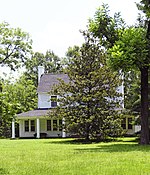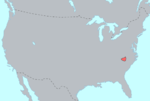The Catawba, also known as Issa, Essa or Iswä but most commonly Iswa (Catawba: Ye Iswąˀ – "people of the river"), are a federally recognized tribe of Native Americans, known as the Catawba Indian Nation. Their current lands are in South Carolina, on the Catawba River, near the city of Rock Hill. Their territory once extended into North Carolina, as well, and they still have legal claim to some parcels of land in that state. They were once considered one of the most powerful Southeastern tribes in the Carolina Piedmont, as well as one of the most powerful tribes in the South as a whole, with other, smaller tribes merging into the Catawba as their post-contact numbers dwindled due to the effects of colonization on the region.
The Catawba were among the East Coast tribes who made selective alliances with some of the early European colonists, when these colonists agreed to help them in their ongoing conflicts with other tribes. These were primarily the tribes of different language families: the Iroquois, who ranged south from the Great Lakes area and New York; the Algonquian Shawnee and Lenape (Delaware); and the Iroquoian Cherokee, who fought for control over the large Ohio Valley (including what is in present-day West Virginia). During the American Revolutionary War the Catawba supported the American colonists against the British. Decimated by colonial smallpox epidemics, warfare and cultural disruption, the Catawba declined markedly in number in the late eighteenth and nineteenth centuries. Some Catawba continued to live in their homelands in South Carolina, while others joined the Choctaw or Cherokee, at least temporarily.
Terminated as a tribe by the federal government in 1959, the Catawba Indian Nation had to reorganize to reassert their sovereignty and treaty rights. In 1973 they established their tribal enrollment and began the process of regaining federal recognition. In 1993 they regained federal recognition and won a $50 million Indian land claims settlement by the federal government and state of South Carolina. The state of South Carolina also recognized the tribe in 1993. Their headquarters are at Rock Hill, South Carolina.
As of 2006, the population of the Catawba Nation has increased to about 2,600, most in South Carolina.The Catawba language, part of the Siouan family (Catawban branch), is being revived.







